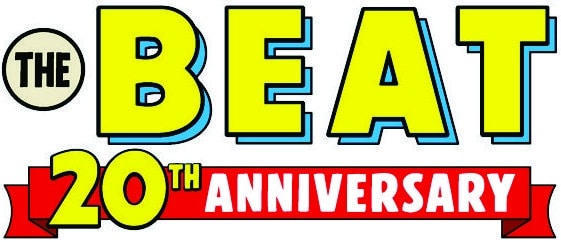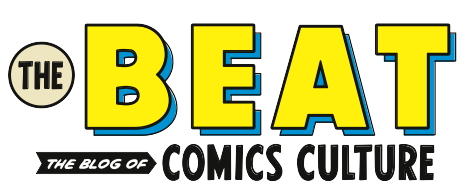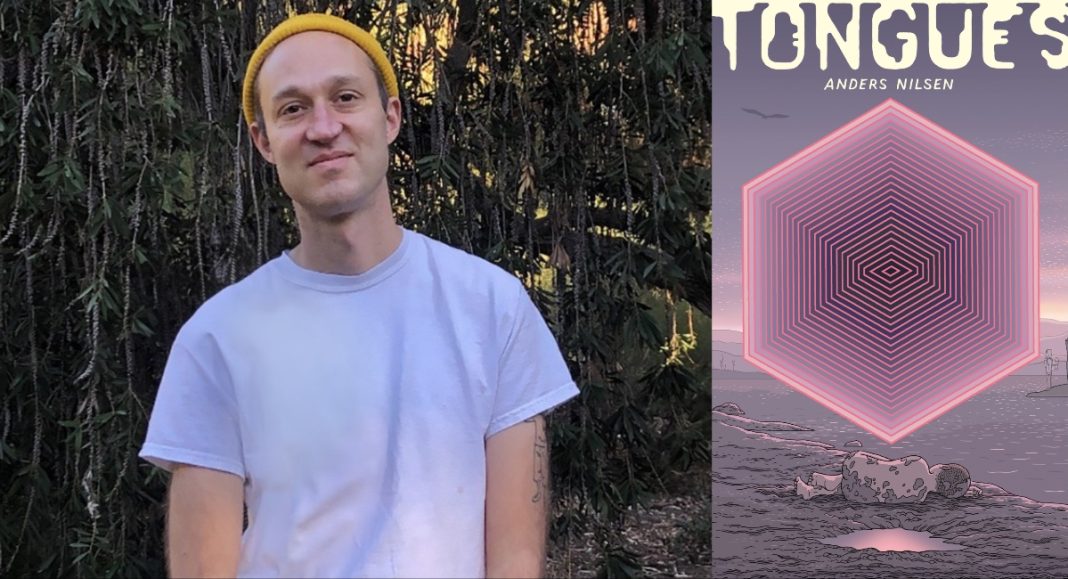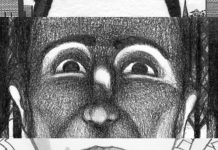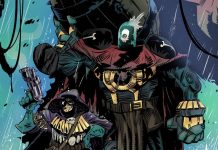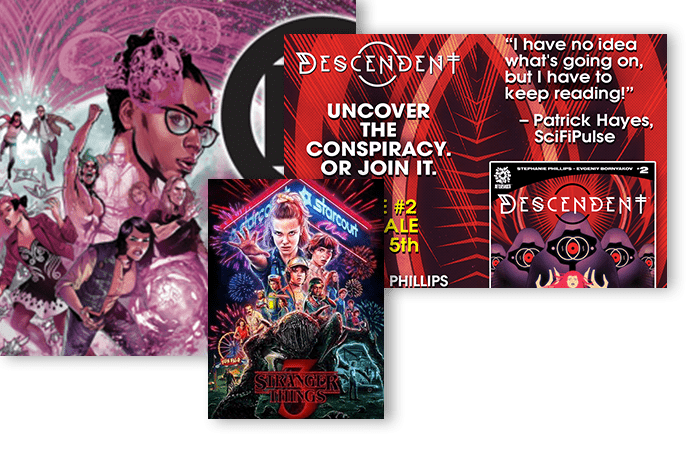Eight years ago, Comics Beat reported that the Publisher’s Weekly fan-favorite, award-winning cartoonist Anders Nilsen‘s new comic Tongues “looks spectacular.” Well, the collected edition of that spectacular work is finally here.
After individual entries were published by the artist himself over the past few years, Penguin Random House imprint Pantheon Books released the first volume of the collected edition on March 11, 2025. Check it out here.
The Beat caught up with Nilsen over email to discuss the release of his new graphic novel, his inspiration for the work, and why his artistic process is so lenghty.
This interview has been edited (ever so slightly) for length.
OLLIE KAPLAN: Though made of geometric shapes, your panel layout is often organic and earthy. Do you have a process for arranging your pages?
ANDERS NILSEN: It’s generally pretty intuitive. There are some overarching ideas, though—scenes in the deep past usually have rounded panel borders, whereas stuff happening in the present is framed in straight edges, for example. That said, I also went into this project with the idea of wanting to play with panel borders in certain ways. So, certain kinds of scenes involve much more panelling. One book reviewer said the early dream/memory sequence in the first scene is obviously meant to reference the ritual reading of entrails, which I absolutely loved. But, I didn’t actually have that thought. Then, I use some heavy frames in some places to give a similarly potent feel to a scene.
Panels are, to me, the basic unit of comics storytelling. Panels are to comics what the sentence, or the phrase, is to prose, but they can be much more than that if you want to play with them that way. There is a way in which they are the frame of reality. They can convey a lot of actual meaning and content, visually. They can create a whole context for a scene. We usually only use them as little containers, but they can be part of the storytelling much more actively.
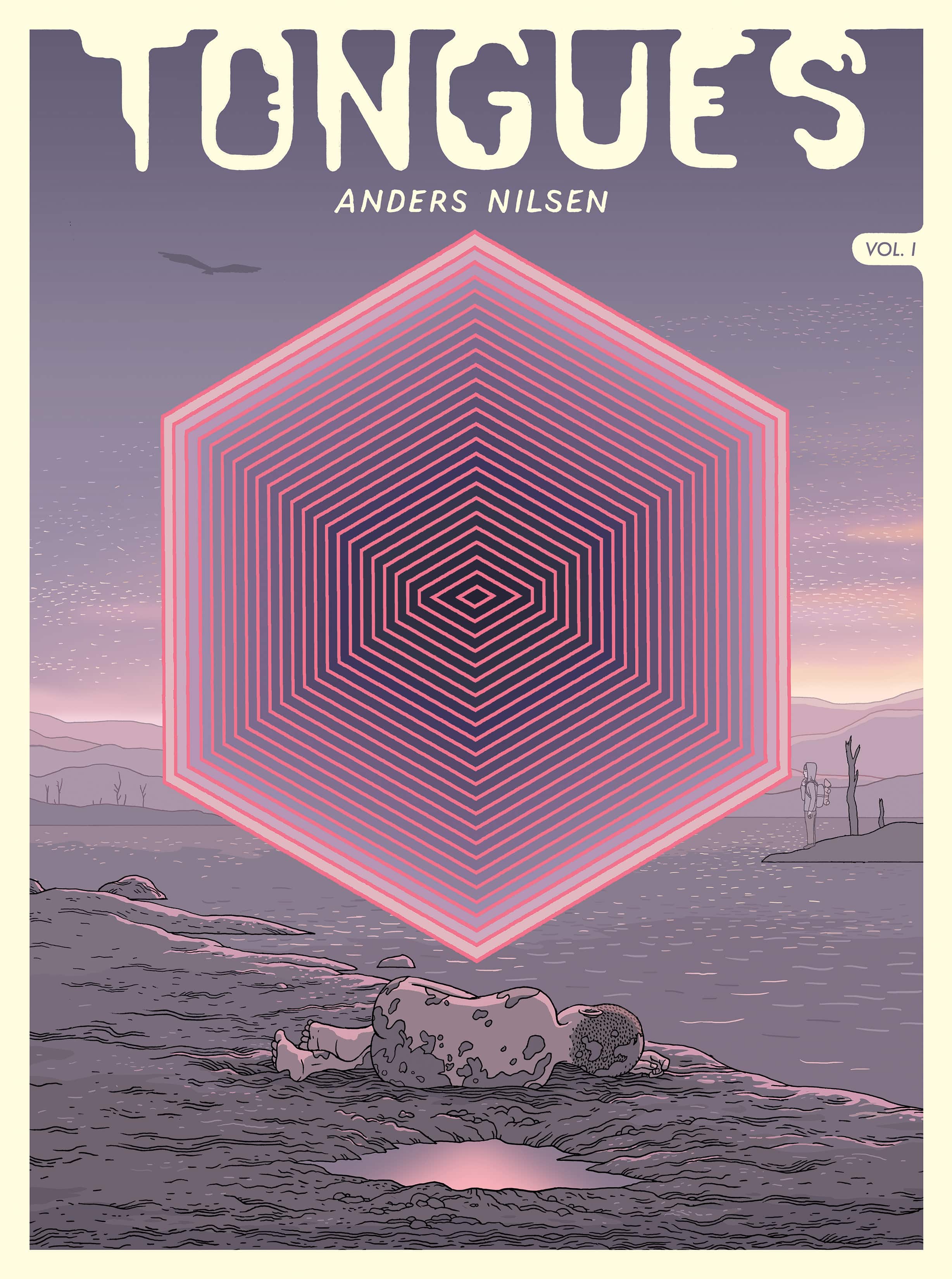
KAPLAN: How does Tongues build upon your previous work?
NILSEN: It’s definitely a kind of culmination. Most of my career to this point has been all over the place. None of my books really looks that much like any of the others in terms of visual style, storytelling style, etc. When I started working on Tongues, I didn’t necessarily mean to bring everything together, but it sort of happened on its own. The ways I play with panels are one example, but also the use of silhouetted imagery, which is many of the book’s themes—playing with mythology and ideas about religion, politics, and divinity. Whereas pretty much every other major project I’ve done has grown out of experiments in my sketchbooks, Tongues has grown out of my other finished works. I plucked one of the main protagonists out of Dogs and Water and Prometheus out of Rage of Poseidon. I’m integrating the abstract ornamental shapes from Big Questions into the narrative in a new way. I’m using mythology in a way that goes back to the Sisyphus story I did for Kramer’s Ergot #4, back in the early aughts.
KAPLAN: With your interest in meaning-making in comics, it makes sense to me that the legend of Prometheus inspired this work. What messages (or meanings) do you hope readers can take away from this story?
NILSEN: Well, hopefully the main thing they take away is that it was an engaging read. But I’m definitely interested in provoking readers to think about who we are as humans. Parts of the book are a meditation on how remarkable we are and how awful many of our effects on the world are. We are a complicated species. A lot of fantasy/sci-fi/heroic fiction is about ‘saving the world,’ which basically means saving ourselves. And it takes for granted that that is a good idea. I’m not necessarily taking the opposite position but interested in messing around in that question.
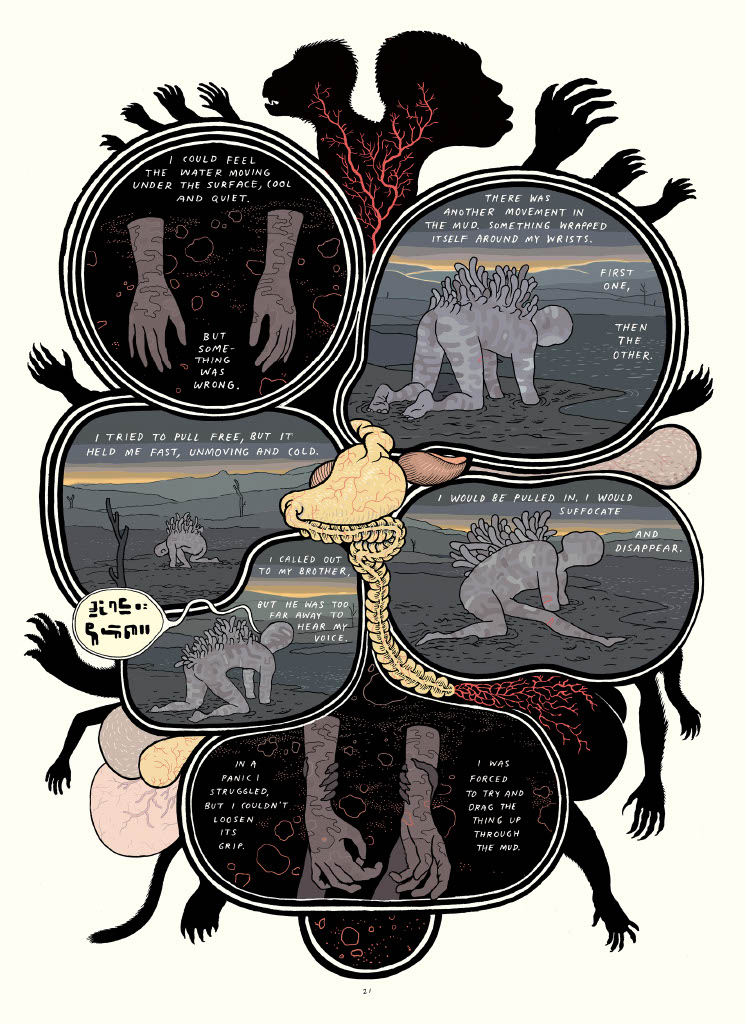
KAPLAN: What attracts you to modern retellings of classic mythology? What else has influenced your work?
NILSEN: As a kid, I was very absorbed by Greek mythology. In particular, some people might know about D’Aulaires’ book on Greek mythology. Ingri D’Aulaire‘s art in that book is so incredibly rich and gorgeous. I probably read that thing through a hundred times. It would have been up there with my Tintin books and X-Men comics, so it’s burned into my brain. I know many of those stories backward and forward, so it’s easy to dip back in and use them as a kind of template to play with. And the added fact that the popular conception of those stories is that they are unredeemably of another time makes it automatically interesting to set them in the present. Unlike Tintin and the X-Men, there are no copyright issues to worry about.
Other influences probably include CS Lewis‘s Narnia stories, as well as his later book Till We Have Faces. J.R.R. Tolkien is hard to deny. There’s also a Norwegian existentialist author, Per Lagerkvist, whom I read a lot back when I first started getting serious about making comics, and his approach to storytelling feels like it’s had an effect on me, too. And I have always had to mention Chester Brown‘s Ed the Happy Clown. To me it’s one of the great masterpieces of comics, or just storytelling in general.
KAPLAN: One of your previous works took 15 years to complete; this one took about 10. Can you tell me more about your artistic process when working on a comic?
NILSEN: Well, my artistic process often involves stories getting longer in the telling than they were in the conception, for sure. Unfortunately, for a big undertaking like this, though, I start with some basic ideas of things I want to incorporate—themes, visual ideas, characters, and I sit with them for a while. Many of the ideas percolated for quite a long time before I started drawing or writing, at least since Sisyphus and Dogs and Water. When I got to the point of actually planning the book, the ideas might not all strictly make sense together, but I’m also interested in throwing some disparate, unrelated elements together to see what happens. Like throwing down some obstructions in my path to make sure I’m not too comfortable with my route through to the other side. I want to make room to make some discoveries along the way. I want to surprise myself a little bit if I can. And then I sit down and start writing. I write a script, at least for the first issue, the first 40-50 pages. Then I thumbnail that, blocking out what’s in each panel. Then I go through and plan out which panels will go on each page, I very roughly pencil – really just to place characters and objects. And ink. The drawing all happens in the inking. That gets scanned, and all the color happens in Photoshop.
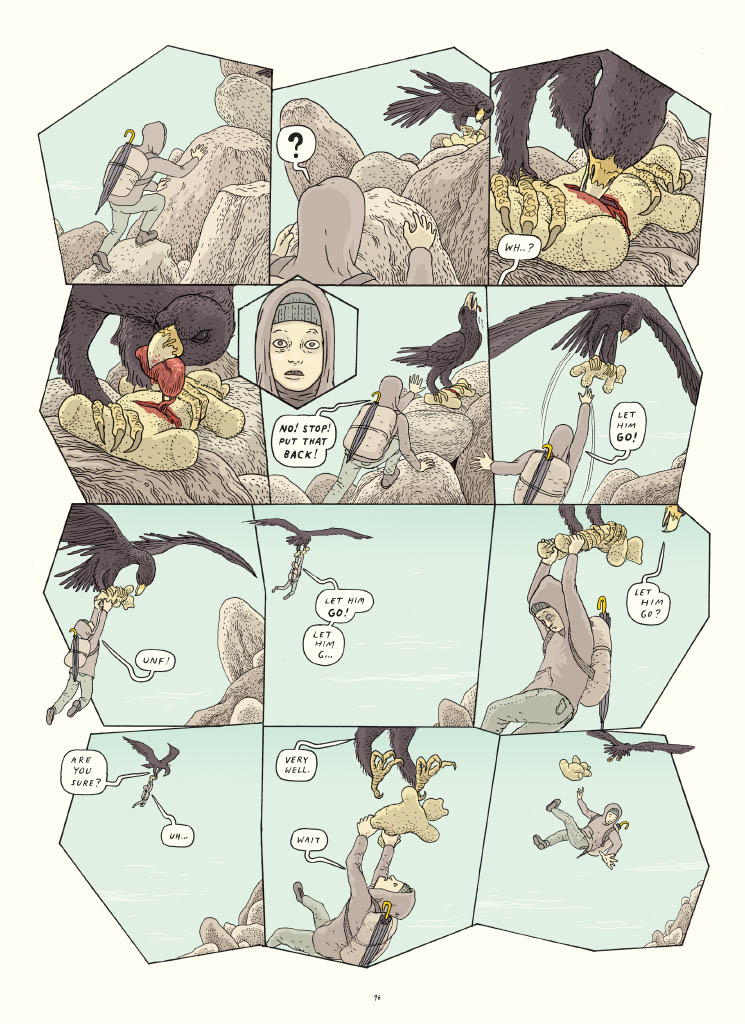
KAPLAN: What is your typical research and development process like when creating a new work? Did you approach Tongues differently than your previous works?
NILSEN: Tongues has involved a lot more research and reference than anything else I’ve done, for sure. Figuring out how to draw eagles right, figuring out how to draw places as widely disparate as Mazar e Sharif in Afghanistan and Nairobi, Kenya believably. The underside of a Humvee. I don’t naturally gravitate to the research part, but it’s necessary, and I’ve tried to embrace it. The book has absolutely stretched my capacities as an artist, which I appreciate. Once upon a time, I was looking at image banks in public libraries. Now Google Image Search is my constant companion.
KAPLAN: Do you have any idea when readers can expect the second volume?
NILSEN: The whole story is maybe 95% scripted and thumbnailed at this point, so I’m reasonably confident that the second volume will come together faster than the first. Fingers crossed. I’ll just say three or four years, and then we can all laugh about it together when the book comes out in 2035.

KAPLAN: Your work regularly explores militarism. Do you think the political climate in 2025 will impact how this work is received?
NILSEN: Yeah, good question, unfortunately. I have no idea. Let’s hope we don’t go back to war. I hope the themes are relevant regardless of who’s in power, but the current regime is really leaning into the argument that humans are woefully underqualified to manage the planet. So maybe that’s good for the book? But I’d rather the book bomb and the planet thrive, if I were given a choice.
KAPLAN: From reading other interviews with you, I understand that your parents were artists too—your mom, a writer; your father, a painter; and your stepmother, an artist. How has that influenced the development of your art?
NILSEN: In different ways. Watching my father and stepmom being artists kind of normalized it for me. Like, this is just a thing people do. And I was definitely encouraged by more or less everyone, my stepfather, too, very much so. Writing and drawing, both. No one ever tried to tell me to do something more responsible or financially viable with my life. Ultimately, they all made their livings in other ways, but that didn’t affect their enthusiasm for my choices. My dad took me aside at some point and let me know that it might not be the easiest way to live, but I think he just felt obliged. I don’t think he was trying to nudge me onto a different path. I feel very lucky that way. I was believed in and supported in my interests. A lot of kids don’t have that.
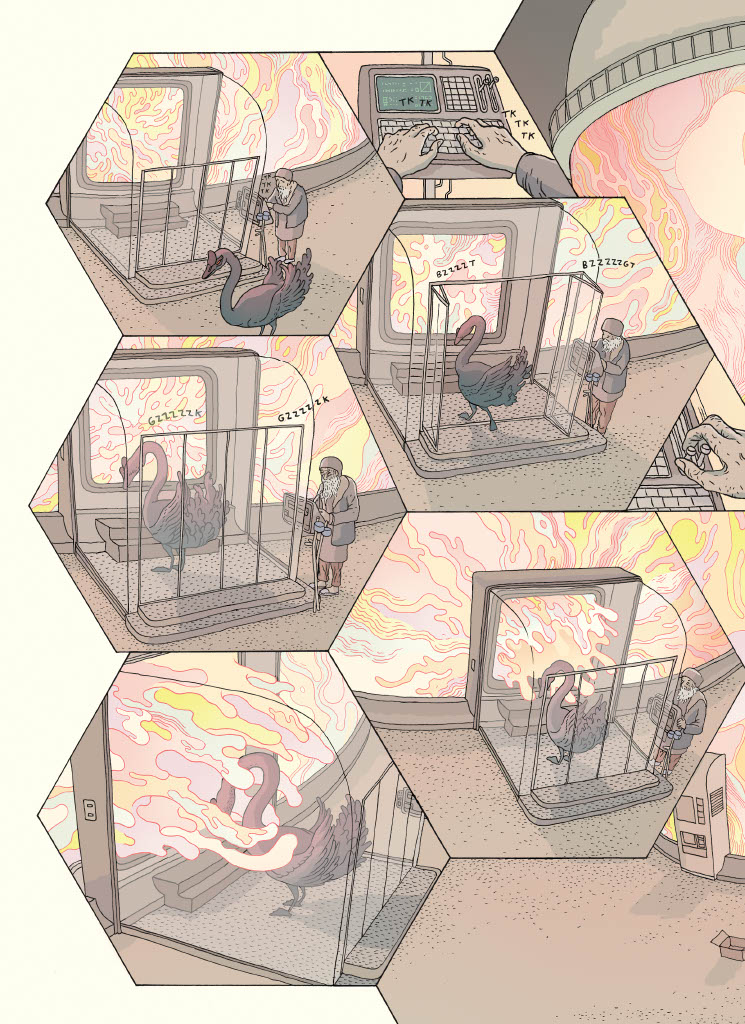
KAPLAN: Both my mother and uncle were fine arts professors at the University of New Mexico, so I was excited to learn you got your BFA there. How did the program and/or the state of New Mexico itself influence your work?
NILSEN: Oh, that’s wild. I love New Mexico. The arts program there was great. It’s very far removed from the big arts centers of, say, New York and LA, of course, but that just sort of forced us to make our own scene. Two of my best friends to this day come from that program. We fed off one another’s work and ideas, and ambitions. The program was very focused on ideas, not technique, which I appreciate. There was certainly no understanding of or interest in comics at that time, but I don’t know that that actually mattered that much, ultimately. Part of me might have liked to get started on comics earlier, but I appreciate that I was forced to experiment and play in a bunch of other sandboxes before settling on one medium. I think it makes my comics more interesting, probably.
KAPLAN: Is there anything else you would like to add?
NILSEN: I don’t know when this will come out, but I’ll just mention this group benefit art show I’m putting together for the Chicago book release. It’s called XLAOOC, or Extra Large and Out of Context. I’m making large-format prints of a bunch of cartoonists’ original art, and contributing the proceeds to the ACLU and Doctors Without Borders. The work will be up for a few months, and the benefit auction will go for a few weeks after the March 25th opening. The other artists include Charles Burns, Chris Ware, Aidan Koch, CF, Kevin Huizenga, Yvan Alagbe, Geneviève Castrée, Laura Park, and Marijpol. And I have a beautiful collaged Fantastic Four page from Jack Kirby. The show is being held at a restaurant I used to cook at back in the early aughts in Chicago, Lula Cafe. I’m super excited about the pieces I was able to get, and very happy to be able to raise a little money for a couple of groups trying to relieve some of the chaos and destruction our current government is wreaking upon the world. So I’d love people to check it out.
Pantheon Books released the first volume of the collected edition of Anders Nilsen’s Tongues on March 11, 2025. Check it out here.
